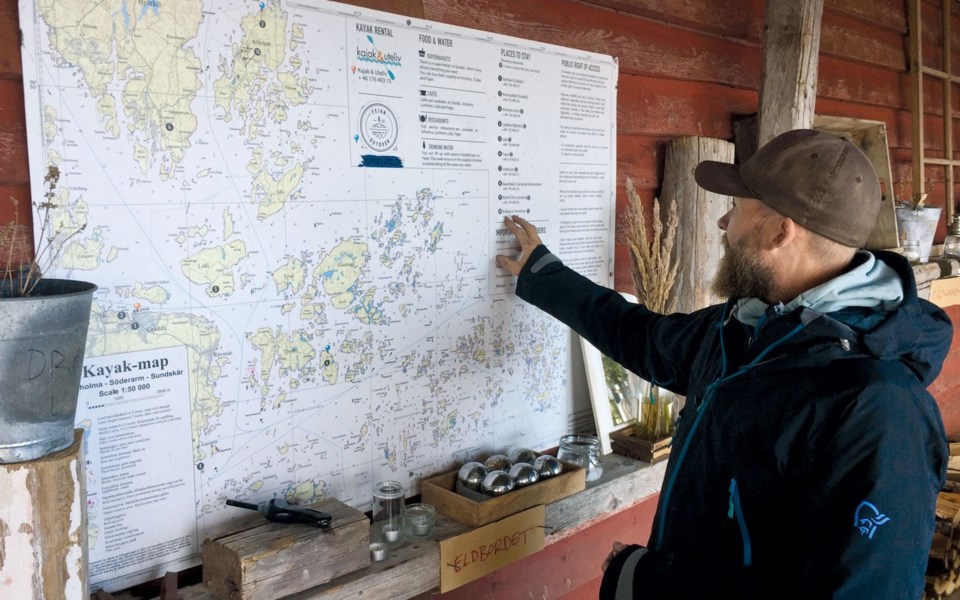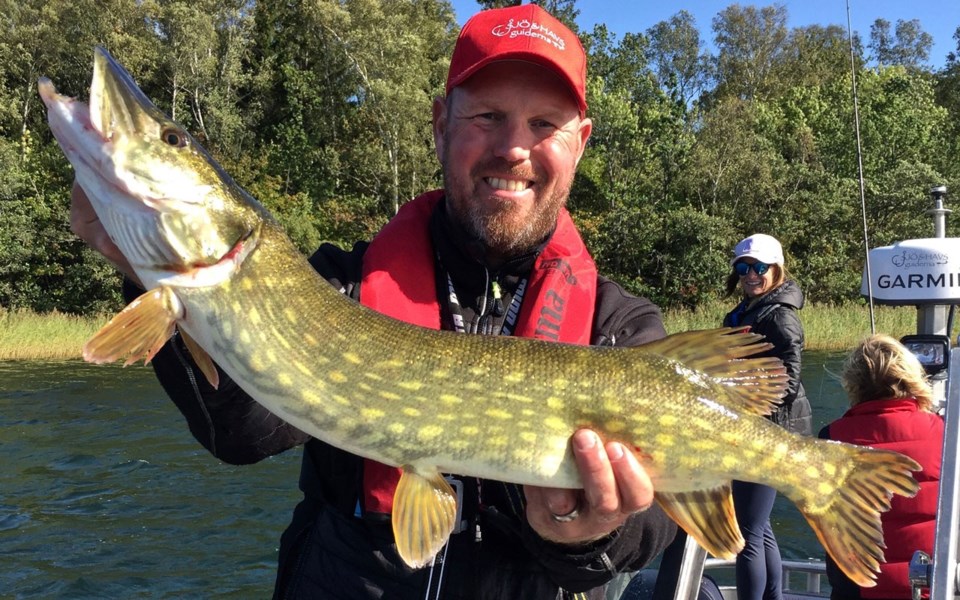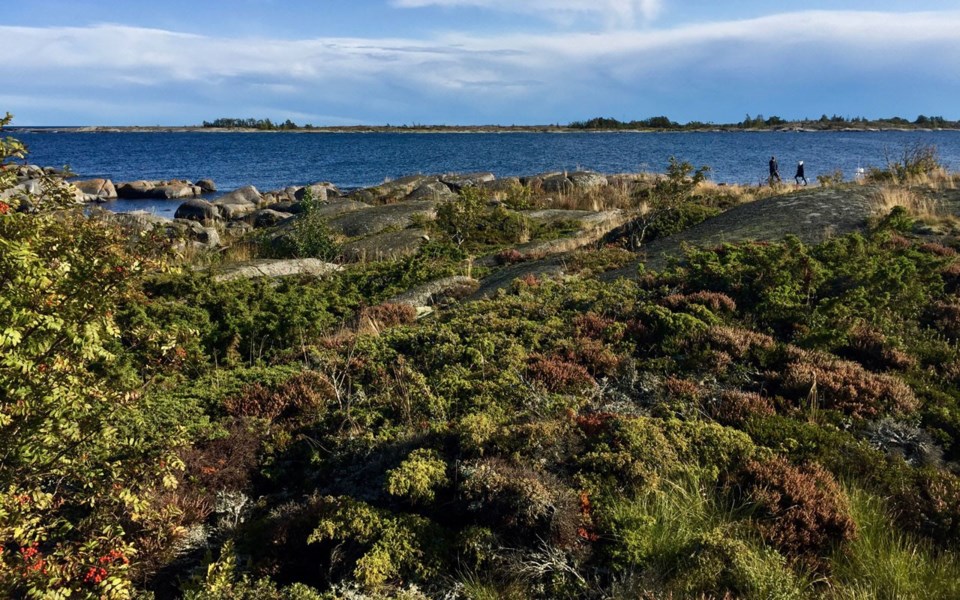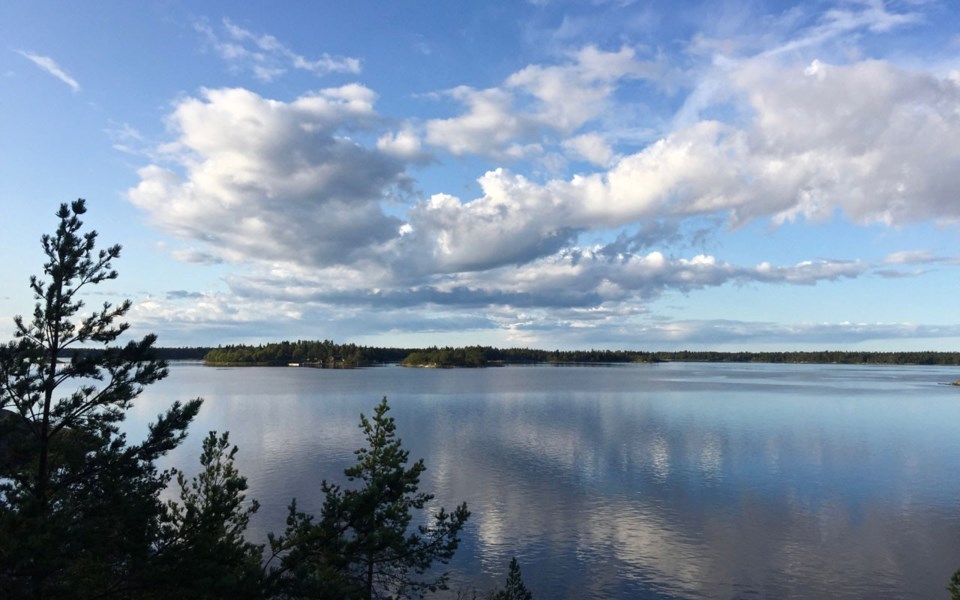
On a warm, sunny autumn day enlivened by a stiff wind, I cast a rubber lure into a weedy bay. As I reel in, letting the lure falter here and there as a real-life wounded minnow might, I feel the heavy tug of a big fish and it's game on.
Eventually I net a feisty Northern Pike of some five kilograms. After a perfunctory photo and releasing it back to its watery umbra, I watch my companions battle similar piscine phantoms (much smaller than my own, I note with satisfaction). It's a fun day of catch-and release, aided in no small way by stellar surroundings.
The spot where my friends Christian and Ulrika keep us "geo-anchored" with a remote-controlled, GPS-enabled electric motor (obviating the need to throw out a bottom-damaging chunk of metal) is one of surpassing boreal beauty—a constellation of pine-picketed islands, limned by a scatter of polished, bare-granite skerries dolphining toward a big-water horizon. Most of the forested islands feature docks with well-worn paths leading up from the water to tidy cottages, shuttered now that summer has passed. As we fish, the kayakers we observed packing up camp on a gorgeous point that morning pass us by with a friendly wave, bound for another idyll on which to spend the night.
As an Ontarian who has spent much time canoeing the iconic landscapes of Algonquin, Muskoka and Georgian Bay, this familiar terraqueous existence speaks to both my heart and soul. But though it softly whispers home, it's actually some 7,000 kilometres removed. And when I mention this, my friends can only say Ja? Because comparable as it may be, this is their home—the Stockholm Archipelago, a glory of 30,000 islets arcing along the Baltic coast of southeast Sweden. Yet there's a definite connection, in both aesthetic and ecological terms.

The Northern Pike is a good starting point, as it's the same species caught in Ontario. But the aquatic pairings go deeper (or shallower, as you'll see): the archipelago also abounds with European Perch, sister species to Canada's Yellow Perch, as well as the much-sought-after Zander, similarly related to our Walleye. This would all be little more than a natural history footnote were we discussing freshwater ecosystems that were recently connected across the Northern Hemisphere, but that isn't the case. In fact, you'd have to go back some 50 million years to the Eocene era to pinpoint the divergence of these fishes—a long period of separation over which to maintain such striking similarities. Beyond deep time, however, the virtual aquatic-fauna doppelganger poses a greater quandary: what are fish that inhabit only freshwater in North America doing in the Baltic Sea?

To begin, like the Great Lakes, the Baltic was created by successive continental glaciations that scoured out its two main branches. With the melting of the final Pleistocene ice sheets some 10,000 years ago, the area filled with freshwater. As the land rebounded and drainages shifted over the next few thousand years, the Baltic alternated between non-saline and saline several times (similar to what occurred in Lake Ontario and the St. Lawrence/Ottawa River valleys). Today the Baltic waters are technically "in between"—the largest area of brackish water on the planet.
Because the relatively narrow Danish Straits are its only saltwater ingress from the North Atlantic, salinity in the Baltic is significantly lower than the open ocean's average of 3.5 per cent, and steadily decreases as you go North and East, varying from 0.6 to 0.8 per cent in its centre to 0.1 per cent in the north. Thousands of freshwater streams and rivers entering from Norway, Sweden, Finland, Russia, Estonia, Lithuania, Latvia, Poland, Germany and Denmark contribute 1/40th of the Baltic's volume, and this water overlies the denser saltwater flowing in from the Danish Straits. Surface water at the lower end of the Gulf of Bothnia, for instance, has no salt taste. As a result, the Baltic features flora and fauna adapted from both regimes to this middle ground, and features slightly divergent forms of plankton, seaweed, shoreline vegetation, invertebrates, and, of course, fishes such as the fresh-to-brackish-water shifting of European Perch and Zander, and salt-to-brackish-water shifting of Baltic herring, a smaller variant of Atlantic herring that once formed the basis of the region's food and commercial trade. The salinity gradient also combines with a parallel North-South temperature gradient to limit many species to relatively narrow regions. In addition, other than storm surges, the Baltic has no tide to speak of, and this "missing" ecological zone has affected which marine species can adapt to the Baltic's low salinity surface waters.

Admittedly this isn't relevant to most clients enjoying a day out with Christian and Ulrika, whose Sjö&Havs not only guides fishers around the archipelago, but engages in significant conservation efforts for these same fish species—just like fishing guides do in Canada. For a biogeography and evolution nerd like myself, however, bobbing amongst familiar glacier-polished rock adorned in familiar boreal plants while catching familiar boreal fishes is more than just dust in the geological wind. It is—I muse as we discuss a shoreline lunch of fresh perch—veritable food for thought.
Leslie Anthony is a biologist, writer and author of several popular books on environmental science.



